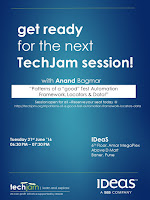- Individual skills & capabilities
- Past experiences
- Existing knowledge / information / expertise on the subject
- Open mindedness
- Willingness to learn
- Current work (tools & tech stack, challenges, risks, priorities, backlog, tech debt, team members, etc.)
The above aspects definitely played a part in what takeaways I had from the recently concluded Selenium Conference 2016 in Bangalore as well.
Here are my key takeaways, which I am going to work on learning more about, or implementing in the near future - special thanks to +Dave Haeffner , +Marcus Merrell , +Simon Stewart, +Bret Pettichord for helping me find these takeaways as part of various conversations during these few days.
- Related to Protractor
- Use Proxy Server in tests (Protractor framework) to capture HAR file on specific actions (AJAX calls) - and capture performance metrics from the same
- Read and experiment with the Marionette driver for Firefox - maybe it helps me overcome some of my challenges with Firefox & Maps in CI environment (headless using xvfb)
- Remove "phantomJS" as a supported browser from my framework by ensuring headless tests work with Chrome & Firefox using xvfb
- Highlight element when running tests before taking screenshots - will help in debugging
- Experiment with different loggers & reporters - Allure, Winston logger
- Better "promise" handling in framework to keep abstraction layers sane
- Revive WAAT - Web Analytics Automation Testing Framework - create new plugin using Proxy Server approach. Also remove Omniture Debugger and HttpSniffer plugin.
- Refocus energy on TTA - Test Trend Analyzer.
- Keep vodQA going strong - its a good community initiative
See you all in Selenium Conference UK in November 2016!



